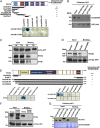Arl1p regulates spatial membrane organization at the trans-Golgi network through interaction with Arf-GEF Gea2p and flippase Drs2p
- PMID: 23345439
- PMCID: PMC3581910
- DOI: 10.1073/pnas.1221484110
Arl1p regulates spatial membrane organization at the trans-Golgi network through interaction with Arf-GEF Gea2p and flippase Drs2p
Abstract
ADP ribosylation factors (Arfs) are the central regulators of vesicle trafficking from the Golgi complex. Activated Arfs facilitate vesicle formation through stimulating coat assembly, activating lipid-modifying enzymes and recruiting tethers and other effectors. Lipid translocases (flippases) have been implicated in vesicle formation through the generation of membrane curvature. Although there is no evidence that Arfs directly regulate flippase activity, an Arf-guanine-nucleotide-exchange factor (GEF) Gea2p has been shown to bind to and stimulate the activity of the flippase Drs2p. Here, we provide evidence for the interaction and activation of Drs2p by Arf-like protein Arl1p in yeast. We observed that Arl1p, Drs2p and Gea2p form a complex through direct interaction with each other, and each interaction is necessary for the stability of the complex and is indispensable for flippase activity. Furthermore, we show that this Arl1p-Drs2p-Gea2p complex is specifically required for recruiting golgin Imh1p to the Golgi. Our results demonstrate that activated Arl1p can promote the spatial modulation of membrane organization at the trans-Golgi network through interacting with the effectors Gea2p and Drs2p.
Conflict of interest statement
The authors declare no conflict of interest.
Figures






Comment in
-
Arl1 gets into the membrane remodeling business with a flippase and ArfGEF.Proc Natl Acad Sci U S A. 2013 Feb 19;110(8):2691-2. doi: 10.1073/pnas.1300420110. Epub 2013 Feb 11. Proc Natl Acad Sci U S A. 2013. PMID: 23401560 Free PMC article. No abstract available.
Similar articles
-
Mechanism of action of the flippase Drs2p in modulating GTP hydrolysis of Arl1p.J Cell Sci. 2014 Jun 15;127(Pt 12):2615-20. doi: 10.1242/jcs.143057. Epub 2014 Apr 4. J Cell Sci. 2014. PMID: 24706946
-
The Arf activator Gea2p and the P-type ATPase Drs2p interact at the Golgi in Saccharomyces cerevisiae.J Cell Sci. 2004 Feb 15;117(Pt 5):711-22. doi: 10.1242/jcs.00896. Epub 2004 Jan 20. J Cell Sci. 2004. PMID: 14734650
-
Arl1 gets into the membrane remodeling business with a flippase and ArfGEF.Proc Natl Acad Sci U S A. 2013 Feb 19;110(8):2691-2. doi: 10.1073/pnas.1300420110. Epub 2013 Feb 11. Proc Natl Acad Sci U S A. 2013. PMID: 23401560 Free PMC article. No abstract available.
-
Multiple activities of Arl1 GTPase in the trans-Golgi network.J Cell Sci. 2017 May 15;130(10):1691-1699. doi: 10.1242/jcs.201319. Epub 2017 May 3. J Cell Sci. 2017. PMID: 28468990 Review.
-
The role of ADP-ribosylation factor and SAR1 in vesicular trafficking in plants.Biochim Biophys Acta. 2004 Jul 1;1664(1):9-30. doi: 10.1016/j.bbamem.2004.04.005. Biochim Biophys Acta. 2004. PMID: 15238254 Review.
Cited by
-
Golgi compartmentation and identity.Curr Opin Cell Biol. 2014 Aug;29:74-81. doi: 10.1016/j.ceb.2014.04.010. Epub 2014 May 17. Curr Opin Cell Biol. 2014. PMID: 24840895 Free PMC article. Review.
-
Arabidopsis Flippases Cooperate with ARF GTPase Exchange Factors to Regulate the Trafficking and Polarity of PIN Auxin Transporters.Plant Cell. 2020 May;32(5):1644-1664. doi: 10.1105/tpc.19.00869. Epub 2020 Mar 19. Plant Cell. 2020. PMID: 32193204 Free PMC article.
-
P4 ATPases: flippases in health and disease.Int J Mol Sci. 2013 Apr 11;14(4):7897-922. doi: 10.3390/ijms14047897. Int J Mol Sci. 2013. PMID: 23579954 Free PMC article. Review.
-
Env7p Associates with the Golgin Protein Imh1 at the trans-Golgi Network in Candida albicans.mSphere. 2016 Aug 3;1(4):e00080-16. doi: 10.1128/mSphere.00080-16. eCollection 2016 Jul-Aug. mSphere. 2016. PMID: 27504497 Free PMC article.
-
A three-stage model of Golgi structure and function.Histochem Cell Biol. 2013 Sep;140(3):239-49. doi: 10.1007/s00418-013-1128-3. Epub 2013 Jul 24. Histochem Cell Biol. 2013. PMID: 23881164 Free PMC article. Review.
References
Publication types
MeSH terms
Substances
LinkOut - more resources
Full Text Sources
Other Literature Sources
Molecular Biology Databases

